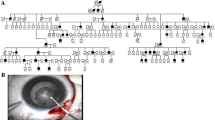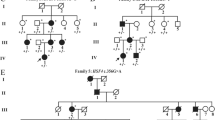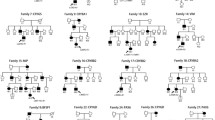Abstract
Background
Congenital cataract is a clinical and genetic heterogeneous group of eye disorders that causes visual impairment and childhood blindness. In this study, a Chinese family with congenital cataract is studied.
Methods
In order to identify the genetic defects which were associated with congenital cataract, a whole-exome sequencing approach is performed to screen for the potential mutation-causing disease.
Results
The result revealed a novel heterozygous mutation (c.433G > T; p.G145W) in exon 2 the of GJA8 gene, which can be detected in all affected individuals, but not the unaffected family members. Meanwhile, this novel mutation cannot be retrieved in 100 healthy local Chinese controls and five other SNPs databases (dbSNP, ESP, ExAC, HTD and HGVD). Moreover, p.G145W was predicted as a mutation with pathogenicity by using bioinformatics methods, including PolyPhen-2, SIFT, PROVEAN, SNPs3D and the mutation significance cutoff (MSC). However, molecular function analysis of this novel mutation (p.G145W, GJA8) indicated that it did not affect the subcellular distributions and the trafficking of GJA8 protein to the plasma membrane. The truth of pathogenic significance with this novel mutation in GJA8 gene needed to be further studied.
Conclusions
The c.433G > T (p.G145W) mutation in the GJA8 gene was first reported to our best knowledge. The results of our study would further broaden the mutation spectrum of GJA8 associated with congenital cataract.





Similar content being viewed by others
References
Churchill A, Graw J (2011) Clinical and experimental advances in congenital and paediatric cataracts. Philos Trans R Soc Lond B Biol Sci 366(1568):1234–1249
Hejtmancik JF (2008) Congenital cataracts and their molecular genetics. Semin Cell Dev Biol 19(2):134–149
Huang B, He W (2010) Molecular characteristics of inherited congenital cataracts. Eur J Med Genet 53(6):347–357
Santana A, Waiswol M, Arcieri ES, Cabral de Vasconcellos JP, Barbosa de Melo M (2009) Mutation analysis of CRYAA, CRYGC, and CRYGD associated with autosomal dominant congenital cataract in Brazilian families. Mol Vis 15:793–800
Hansen L, Mikkelsen A, Nürnberg P, Nürnberg G, Anjum I, Eiberg H, Rosenberg T (2009) Comprehensive mutational screening in a cohort of Danish families with hereditary congenital cataract. Invest Ophthalmol Vis Sci 50(7):3291–3303
Yi J, Yun J, Li ZK, Xu CT, Pan BR (2011) Epidemiology and molecular genetics of congenital cataracts. Int J Ophthalmol 4(4):422–432
Wang L, Luo Y, Wen W, Zhang S, Lu Y (2011) Another evidence for a D47N mutation in GJA8 associated with autosomal dominant congenital cataract. Mol Vis 17:2380–2385
Lee I-H, Lee K, Hsing M, Choe Y, Park J-H, Kim SH, Bohn JM, Neu MB, Hwang KB, Green RC, Kohane IS, Kong SW (2014) Prioritizing disease-linked variants, genes, and pathways with an interactive whole-genome analysis pipeline. Hum Mutat 35:537–547
Arnold K, Bordoli L, Kopp J, Schwede T (2006) The SWISS-MODEL workspace: a web-based environment for protein structure homology modeling. Bioinformatics 22:195–201
Ng PC, Henikoff S (2003) SIFT: predicting amino acid changes that affect protein function. Nucleic Acids Res 31(13):3812–3814
Yue P, Melamud E, Moult J (2006) SNPs3D: candidate gene and SNP selection for association studies. BMC Bioinf 7:166
Itan Y, Shang L, Boisson B (2016) The mutation significance cutoff: gene-level thresholds for variant predictions. Nat Methods 13(2):109–110
Shiels A, Hejtmancik JF (2013) Genetics of human cataract. Clin Genet 84:120–127
Lachke SA, Ho JW, Kryukov GV, O’Connell DJ, Aboukhalil A, Bulyk ML, Park PJ, Maas RL (2012) iSyTE: integrated Systems Tool for Eye gene discovery. Invest Ophthalmol Vis Sci 53:1617–1627
Maeda S, Nakagawa S, Yamashita E, Suga M, Fujiyoshi Y, Oshima A, Tsukihara T (2009) Structure of the connexin 26 gap junction channel at 3.5 a resolution. Nature 458:597–602
Xin L, Gong XQ, Bai D (2010) The role of amino terminus of mouse C × 50 in determining transjunctional voltage-dependent gating and unitary conductance. Biophys J 99:2077–2086
Santana A, Waiswo M (2011) The genetic and molecular basis of congenital cataract. Arq Bras Oftalmol 74:136–142
Beyer EC, Berthoud VM (2014) Connexin hemichannels in the lens. Front Physiol 5:20
Yeager M, Harris AL (2007) Gap junction channel structure in the early 21st century: facts and fantasies. Curr Opin Cell Biol 19:521–528
White TW (2002) Unique and redundant connexin contributions to lens development. Science 295:319–320
White TW, Bruzzone R, Wolfram S, Paul DL, Goodenough DA (1994) Selective interactions among the multiple connexin proteins expressed in the vertebrate lens: the second extracellular domain is a determinant of compatibility between connexins. J Cell Biol 125:879–892
White TW, Goodenough DA, Paul DL (1998) Targeted ablation of connexin 50 in mice results in microphthalmia and zonular pulverulent cataracts. J Cell Biol 143:815–825
Sellitto C, Li L, White TW (2004) Connexin50 is essential for normal postnatal lens cell proliferation. Invest Ophthalmol Vis Sci 45:3196–3202
Pal JD, Berthoud VM, Beyer EC, Mackay D, Shiels A, Ebihara L (1999) Molecular mechanismunderlying a CX50-linked congenital cataract. Am J Physiol 276:C1443–C1446
Mackay DS, Bennett TM, Culican SM, Shiels A (2014) Exome sequencing identifies novel and recurrent mutations in GJA8 and CRYGD associated with inherited cataract. Hum Genome 8:19
Vanita V, Singh JR, Hejtmancik JF et al (2006) A novel fan-shaped cataract-microcornea syndrome caused by a mutation of CRYAA in an Indian family. Mol Vis 12:518–522
Graw J, Klopp N, Illig T et al (2006) Congenital cataract and macular hypoplasia in humans associated with a de novo mutation in CRYAA and compound heterozygous mutations in P. Graefes Arch Clin Exp Ophthalmol 244:912–919
Willoughby CE, Arab S (2003) A novel GJA8 mutation in an Iranian family with progressive autosomal dominant congenital nuclear cataract. J Med Genet 40:e124
Devi RR, Vijayalakshmi P (2006) Novel mutations in GJA8 associated with autosomal dominant congenital cataract and micro cornea. Mol Vis 12:190–195
Berry V, Mackay D, Khaliq S et al (1999) Connexin 50 mutation in a family with congenital “zonular nuclear” pulverulent cataract of Pakistani origin. Hum Genet 105:168–170
Zheng JQ, Ma ZW, Sun HM (2005) A heterozygous transversion of connexin 50 in a family with congential nuclear cataract in the northeast of China. Zhonghua Yi Xue Yi Chuan Xue Za Zhi 22:76–78
Vanita V, Hennies HC, Singh D et al (2006) A novel mutation in GJA8 associated with autosomal dominant congenital cataract in a family of Indian origin. Mol Vis 12:1217–1222
Shiels A, Mackay D, Lonides A et al (1998) A missense mutation in the human Connexin 50 gene (GJA8) underlies the dominant “zonular pulverulent” cataract, on chromosome 1q. Am J Hum Genet 62:526–532
Arora A, Minogue PJ, Liu X et al (2006) A novel GJA8 mutation is associated with autosomal dominant lamellar pulverulent cataract: further evidence for gap junction dysfunction in human cataract. J Med Genet 43:e2
Polyakov AV, Shagina IA, Khlebnikova OV et al (2001) Mutation in the connexin 50 gene (GJA8) in a Russian family with zonular pulverulent cataract. Clin Genet 60:476–478
Yan M, Xiong C, Ye SQ et al (2008) A novel connexin 50 (GJA8) mutation in a Chinese family with a dominant congenital pulverulent nuclear cataract. Mol Vis 14:418–424
Vanita V, Singh JR, Singh D et al (2008) A novel mutation in GJA8 associated with jellyfish-like cataract in a family of Indian origin. Mol Vis 14:323–326
Arora A, Minogue PJ, Liu X et al (2008) A novel connexin50 mutation associated with congenital nuclear pulverulent cataract. J Med Genet 45:155–160
Hansen L, Yao W, Eiberg H et al (2007) Genetic heterogeneity in microcornea-cataract: five novel mutations in CRYAA, CRYGD, and GJA8. Invest Ophthalmol Vis Sci 48:3937–3944
Hu S, Wang B, Zhou Z et al (2010) A novel mutation in GJA8 causing congenital cataract–microcornea syndrome in a Chinese pedigree. Mol Vis 16:1585–1592
Kronengold J, Trexler EB, Bukauskas FF et al (2003) Single-channel SCAM identifies pore-lining residues in the first extracellular loop and first transmembrane domains of Cx46 hemichannels. J Gen Physiol 122(4):389–405
White TW, Bruzzone R, Wolfram S et al (1994) Selective interactions among the multiple connexin proteins expressed in the vertebrate lens: the second extracellular domain is a determinant of compatibility between connexins. J Cell Biol 125(4):879–892
Acknowledgments
Authors’ contributions: MR and XGY for bioinformatics analysis and writing of the manuscript. XJD and JAX for discussion and comments on an earlier version of the manuscript. All authors read and approved the final manuscript.
Author information
Authors and Affiliations
Corresponding author
Ethics declarations
Funding
Xi’an science and technology bureau provided financial support in the form of science and technology project of Xi’an funding (HM1116 (1)). The sponsor had no role in the design or conduct of this research.
Competing interests
All authors certify that they have no affiliations with or involvement in any organization or entity with any financial interest (such as honoraria; educational grants; participation in speakers’bureaus; membership, employment, consultancies, stock ownership, or other equity interest; and expert testimony or patent-licensing arrangements), or non-financial interest (such as personal or professional relationships, affiliations, knowledge or beliefs) in the subject matter or materials discussed in this manuscript.
Ethical approval
All procedures performed in studies involving human participants were in accordance with the ethical standards of the institutional and/or national research committee and with the 1964 Helsinki declaration and its later amendments or comparable ethical standards.
Informed consent
Informed consent was obtained from all individual participants included in the study. Additional informed consent was obtained from all individual participants for whom identifying information is included in this article.
Additional information
An erratum to this article is available at http://dx.doi.org/10.1007/s00417-016-3557-x.
Rights and permissions
About this article
Cite this article
Ren, M., Yang, X.G., Dang, X.J. et al. Exome sequencing identifies a novel mutation in GJA8 associated with inherited cataract in a Chinese family. Graefes Arch Clin Exp Ophthalmol 255, 141–151 (2017). https://doi.org/10.1007/s00417-016-3513-9
Received:
Revised:
Accepted:
Published:
Issue Date:
DOI: https://doi.org/10.1007/s00417-016-3513-9




